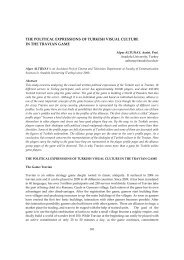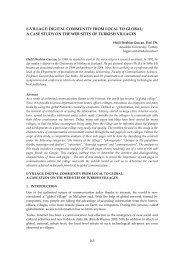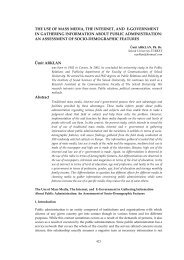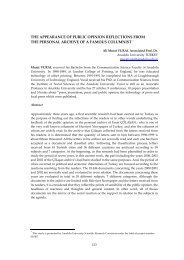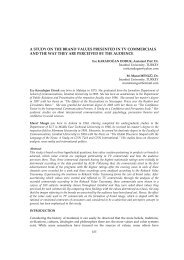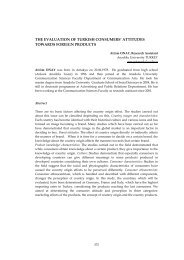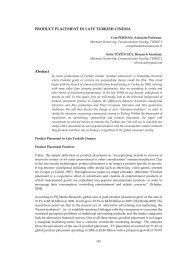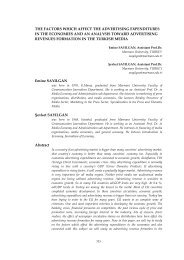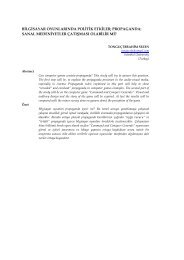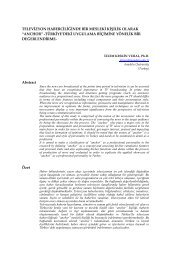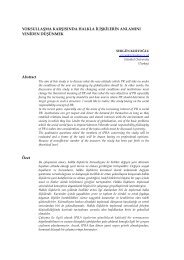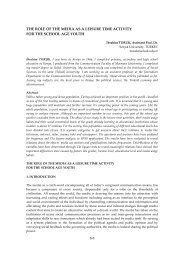an interdisciplinary assay upon internet and social advertising ...
an interdisciplinary assay upon internet and social advertising ...
an interdisciplinary assay upon internet and social advertising ...
You also want an ePaper? Increase the reach of your titles
YUMPU automatically turns print PDFs into web optimized ePapers that Google loves.
concept to define a various r<strong>an</strong>ge of notions from multi-functional electronic devices to<br />
agriculturally designed seeds, from dual combustion environmental-friendly cars to comp<strong>an</strong>ies<br />
embracing Americ<strong>an</strong> <strong>an</strong>d Jap<strong>an</strong>ese m<strong>an</strong>agement styles, from multi-racial people to double<br />
nationalities <strong>an</strong>d post-colonial cultures. (Weeks, 2002, p.2) (The areas that the concept defines<br />
show a big variety just as the concept’s me<strong>an</strong>ing itself.)<br />
3.3. New Media<br />
While the mass communication media such as newspapers, magazines, books, radio, cinema<br />
<strong>an</strong>d television are called the traditional media, the ch<strong>an</strong>nels that the new communications<br />
technologies provide are named as the new media. New media is differentiated from the<br />
traditional media by three import<strong>an</strong>t characteristics: “interactivity, asynchrony <strong>an</strong>d<br />
demassification” (Rogers, 1995; Tr<strong>an</strong>sferred by, Geray, 2003, p.18). The new media’s interactive<br />
dimension is continuously updated. New generation applications, not only allow user<br />
interactivity through clicking, page refreshing <strong>an</strong>d moving forward but also make the software<br />
appeal to more th<strong>an</strong> one sense. This way, the concept of cyber reality becomes more th<strong>an</strong> a<br />
simulation of real life, but instead it comes to recognition as a concept within the real life that<br />
c<strong>an</strong> be perceived by different senses in real-time.<br />
The electronic information era, shaped under the light of technological adv<strong>an</strong>ces that happen by<br />
the minute, has ch<strong>an</strong>ging requisites <strong>an</strong>d that’s why the communication methods also renew<br />
themselves in different ways. With the new media applications that are added to the concept of<br />
communication every single day, it undertakes different me<strong>an</strong>ings <strong>an</strong>d interpretations. In this<br />
era of speed in which, as McLuh<strong>an</strong> emphasized, “everybody deals with everybody, everybody<br />
knows about everybody on every inst<strong>an</strong>ce” (McLuh<strong>an</strong> Marshall, 2005, p.16), a new “form of<br />
dialogue” that is valid on the whole world, is created through electric circuits. The way this<br />
dialogue was formed conveys the idea of ch<strong>an</strong>ge on the whole, in terms of <strong>social</strong>, economic <strong>an</strong>d<br />
political terms. The process of contemporary societies moving from written cultures towards a<br />
more visual culture, has affected the communication industry in m<strong>an</strong>y aspects <strong>an</strong>d brought<br />
corporate <strong>an</strong>d cultural ch<strong>an</strong>ges.<br />
With the globalization, it became unavoidable that new communication technologies had to be<br />
improved <strong>an</strong>d that communication policies had to adapt to the new world order. The<br />
traditional media approach in which all the communication technologies were central <strong>an</strong>d a<br />
one-way relationship was formed between the receiver <strong>an</strong>d the sender; started to leave its<br />
throne to the new media concept that emphasized individual preferences <strong>an</strong>d focused on the<br />
single individual as both the receiver <strong>an</strong>d the sender. The new media’s target audience: “the<br />
single individual” is also part of a crowd just as in the pre-industrial revolution period. This<br />
crowd in the cyber world, shares common grounds not as in birth place, family or village (as<br />
freed from all geographic constraints), but cultural similarities as in professional exch<strong>an</strong>ges,<br />
common interests, similar taste in music. Th<strong>an</strong>ks to communication technologies, information<br />
has become the main element to share in the new media <strong>an</strong>d the new world order <strong>an</strong>d also, the<br />
determin<strong>an</strong>t factor in global economy. The tr<strong>an</strong>sformation of information into a determin<strong>an</strong>t<br />
factor in global economy, is due to the improvements in v-computer technologies. “The birth of<br />
information, not only as a concept, but as <strong>an</strong> ideology is undeniably related to the adv<strong>an</strong>ces in<br />
computers.” (Kumar, K., 1995, p.20). Besides the cultural, economical <strong>an</strong>d artistic influences,<br />
<strong>an</strong>other effect of the adv<strong>an</strong>ces in computer technologies <strong>an</strong>d the Internet is the emerging of new<br />
communication tools in the cyber world. The technologies of written, oral <strong>an</strong>d visual<br />
communications <strong>an</strong>d the need for societies to access information <strong>an</strong>d to communicate<br />
influenced each other mutually. The new communication vehicles equipped with new<br />
278



